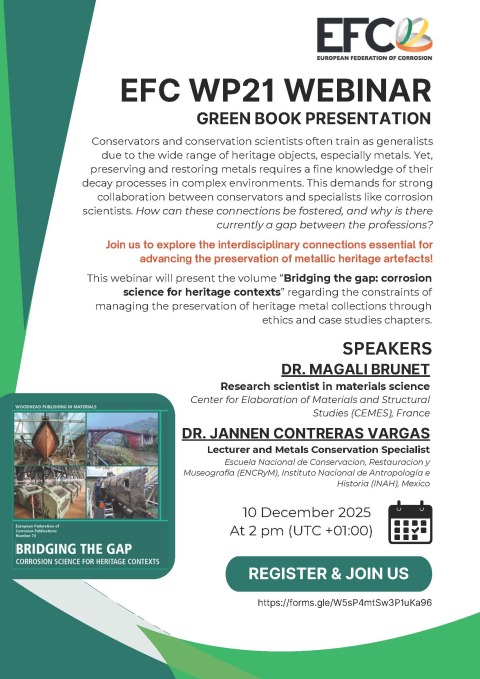Current Activities
Publication
The activities of the European Federation of Corrosion (EFC) and of the Working Party 21 Corrosion of Archaeological and Historical Artefacts aim to bring together conservators, conservation scientists and corrosion scientists into conversation to develop these links.
In that frame of mind, the volume “BRIDGING THE GAP: CORROSION SCIENCE FOR HERITAGE CONTEXTS” presents the constraints of managing the preservation of heritage metal collections through ethics and case studies chapters. It introduces examples of interdisciplinary studies showing the contribution of corrosion sciences to the understanding of corrosion mechanisms in the heritage field or to the development of innovative preservation protocols. This volume intends to inspire collaborative thought process and action by explaining the unique challenges that heritage metals present for corrosion science. The book is aimed at conservators, conservation scientists, archaeologists and corrosion scientists as well as to the students of all these disciplines interested in heritage metals (scheduled publication spring 2025).
As part of the publication of this work, we are organising webinars dedicated to its presentation, which will provide an opportunity for discussion on the issues of research convergence and the challenges posed by the development of new practices in the preservation of metallic artefacts. This first webinar took place on 21 January 2025 (see "Events tab").
Next Webinar:
Green Book Presentation "Bridging the gap corrosion science for heritage contexts"
online, 10 December 2025, 14:00 CET (UCT + 01:00)
Organised by EFC WP 21
Conservators and conservation scientists often train as generalists
due to the wide range of heritage objects, especially metals. Yet,
preserving and restoring metals requires a fine knowledge of their
decay processes in complex environments. This demands for strong
collaboration between conservators and specialists like corrosion
scientists. How can these connections be fostered, and why is there
currently a gap between the professions?
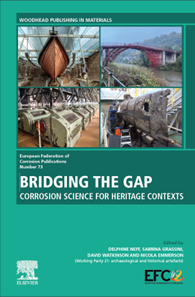
EFC ‘Green Book’ No. 73: "BRIDGING THE GAP: CORROSION SCIENCE FOR HERITAGE CONTEXTS"
Edited by D. Neff (CEA), D. Watkinson (Cardiff University), S. Grassini (Politecnico di Torino) and N. Emmerson (Cardiff University)
Woodhead Publishing, 1st Edition, 530 pages, 11 June 2025, Hardback ISBN: 9780443186905, eBook ISBN: 9780443186912
Bridging the Gap: Corrosion Science For Heritage Contexts explores the decision-making processes for preserving heritage metals while also examining the collaborative, interdisciplinary relationships that underpin them. Through themed chapters, the book is designed to develop and strengthen collaboration between these three groups of professionals, creating a synergy that benefits research and practice for the preservation of heritage metals. It builds an overview of metals conservation across a broad range of heritage contexts, from indoor museum displays to fixed outdoor structures and moving objects.
Researchers and practitioners provide critical insights into corrosion problems within heritage, current corrosion mitigation procedures, and the evidence supporting best practice guidance. The book will be a valuable reference resource for corrosion and corrosion protection scientists, heritage preservation scientists, conservation practitioners, and students studying preservation of cultural objects.
Online Ordering - Elsevier Book Store
Business Meeting
Next Business Meeting at the upcoming EUROCORR
- Minutes from recent WP 21 meetings
Get involved!
If you wish get involved with EFC and the activities of the Working Party please click here to register!
Mission statement of the Working Party
To build and reinforce connections between conservation practitioners, conservation scientists and corrosion scientists on shared objectives:
- To understand the corrosion mechanisms that change the chemistry and morphology of cultural heritage metals.
- To develop and assess the performance of corrosion control methods for cultural heritage metals.
- To develop and improve long term monitoring strategies of corrosion risk for heritage metals in storage, on display and in-situ.
- To contribute to the ongoing long term preservation of metallic heritage.
Presentation WP21 (2024)
Events
EFC WP21 webinars - green book presentation
Announcement:
Conservators and conservation scientists are often train as generalists due to the broad material scope of heritage objects and in particular metallic ones. Yet, the preservation and restoration procedures of metals require a fine knowledge of decay processes occurred in complex and changing environments. This demands robust linkage between the conservators and relevant specialist professions such as corrosion scientists, where metals are involved. How can such links be established and why does a gap currently exist between the professions?
The activities of the European Federation of Corrosion (EFC) and of the Working Party 21 Corrosion of Archaeological and Historical Artefacts aim to bring together conservators, conservation scientists and corrosion scientists into conversation to develop these links. In that frame of mind, the volume “BRIDGING THE GAP: CORROSION SCIENCE FOR HERITAGE CONTEXTS” presents the constraints of managing the preservation of heritage metal collections through ethics and case studies chapters. It introduces examples of interdisciplinary studies showing the contribution of corrosion sciences to the understanding of corrosion mechanisms in the heritage field or to the development of innovative preservation protocols. This volume intends to inspire collaborative thought process and action by explaining the unique challenges that heritage metals present for corrosion science. The book is aimed at conservators, conservation scientists, archaeologists and corrosion scientists as well as to the students of all these disciplines interested in heritage metals (scheduled publication spring 2025).
As part of the publication of this work, we are proposing webinars dedicated to its presentation, which will provide an opportunity for discussion on the issues of research convergence and the challenges posed by the development of new practices in the preservation of metallic artefacts.
2nd webinar: 10 December 2025, 14:00 CET (UTC + 01:00)
1st webinar: 21 January 2025
This first webinar will be held on the 21st of January at 10 am (Paris time) during one hour and starts by the two presentations, support for initiating a dialog between Tadeja Kosec, corrosionist and Peter Meehan, conservator. The discussion was moderated by the Chairs of the WP21 of the EFC (Sabrina Grassini, Dave Watkinson, Nicola Emmerson and Delphine Neff).
Speakers’ short bios
Dr. Tadeja Kosec, Head of Laboratory for Metals, Corrosion and Anti-corrosion Protection
Tadeja Kosec is a chemist at the Slovenian National Building and Civil Engineering Institute (Research institute) and has been involved in electrochemical characterization of materials for 23 years. Her research is devoted to electrochemical characterization of different materials, with special emphasis on copper alloys, nickel and titanium alloys, steels and stainless steels. She specializes in passivation, corrosion, corrosion protection and inhibition. In recent years, lots of work is devoted into finding corrosion phenomena through various monitoring techniques. She is involved in international projects, R&D industrial projects and national research projects. Her work is well documented in more than 90 papers in refereed journals and 100 + conference papers. In the field of bronze corrosion protection, research began in 2008 as a small applied project commissioned by the Municipality of Ljubljana, Slovenia. Over time, this initiative grew into a significant area of focus for her research group, broadening its scope and impact internationally (coordination of the B-impact project).
Peter Meehan, conservator
Peter Meehan trained as a conservator at Cardiff University in the mid 1980's before going to work as an object conservator at the Museum of London. This was followed by a period of time working as a metals conservator at the British Museum where he worked on Asiatic and Ethnographic metalwork. In 1996 he took over as Conservation Manager for the Science Museum at the Large Objects Store at Wroughton airfield near Swindon. In 2001 he moved into private practice and in 2011 set up his own consultancy business advising on the conservation of historic metalwork for all those who have these objects in their care. He became an Institute of Conservation accredited conservator in 2013 and today works for a broad range of clients that include organisations like the National Trust as well as museums, contractors and those involved in the preservation of historic metals without conservation expertise. He is also completing his PhD study at Cardiff University which focuses on assessment of protective coatings for exterior ironwork.
- Chair of ICOM-CC Metals WG - Dr Nicola Emmerson

- Triennal meeting of the ICOM-CC Metals WG
- Proceedings 2010 – 2022 are available online as free downloads
- Contributions by members of EFC WP21
- The Metal Group Triennials bring together between 150 and 400 practising conservators, conservation scientists, corrosion science professionals and historians to discuss the structure, decay, analysis, treatment, display and cultural context of metal heritage. Science presentations run alongside case histories of treatments and ethical discussion of conservation procedure. The eclectic mix of presentations provides a useful introductory platform for science professionals to find out more about the scope and breadth of conservation, the range of specialisms within it and how these integrate to deliver conservation practice. The conference generates formative and interesting discussion due to the range of disciplines represented by its delegates. Dating back to the first conference in 1992, the conference proceedings provide an important publication source for metal conservators. Collectively, they are the biggest and most important metal specific publications available within the heritage sector.
Publications
Materials and Corrosion 2016
Corrosion of Archaeological and Historical Artefacts
Material Corrosion, 67 (2016)
This important publication offers a wide range of science focused publications for the metals conservator and corrosion scientist. It covers treatment design and assessement, as well as corrosion mechanisms and routes.
https://doi.org/10.1002/maco.201670024
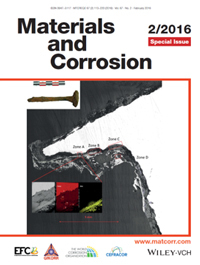
Corrosion and conservation of cultural heritage metallic artefacts (EFC 65)
Edited by P. Dillmann, CNRS/CEA, France, D. Watkinson, Cardiff University, UK, E. Angelini, Politecnico di Torino, Italy and A. Adriaens, Ghent University, Belgium
Woodhead Publishing, July 2013, 640 pages, hardback, ISBN-13: 978 1 78242 154 2
The conservation of metallic archaeological and historic artefacts presents major challenges, whether they are ancient bronzes or relics of our more recent industrial past. Based on the work of Working Party 21 Corrosion of Archaeological and Historical Artefacts within the European Federation of Corrosion (EFC), this important book summarises key recent research on analytical techniques, understanding corrosion processes and preventing the corrosion of cultural heritage metallic artefacts.
The book begins by introducing key conservation issues for heritage metals. This is followed by a review of techniques for measuring and analysing corrosion processes, including time resolved spectroelectrochemistry, voltammetry and laser induced breakdown spectroscopy. Part three reviews different types of corrosion processes for a range of artefacts, whilst part four discusses on-site monitoring techniques. The final part of the book summaries a range of conservation techniques and strategies to conserve cultural heritage metallic artefacts.
Corrosion and conservation of cultural heritage metallic artefacts is an important reference for all those involved in archaeology and conservation, including governments, museums as well as those undertaking research in archaeology and corrosion science.
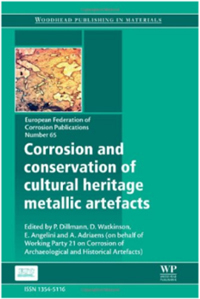
Corrosion metallic heritage artefacts (EFC 48) Investigation, conservation and prediction for long-term behaviour
Edited by P. Dillmann, G. Béranger, P. Piccardo and H. Matthiesen
Woodhead Publishing, March 2007, 416pp hardback, ISBN 978 1 84569 239 1(book), ISBN 978 1 84569 301 5 (e-book)
Understanding long term corrosion processes of metals is critical wherever they are in use, including archaeology and heritage conservation. This book reviews key themes such as the processes underlying corrosion over long periods, how corrosion rates can be measured and approaches to conserving metallic heritage.
The book begins with an introduction to the study and conservation of metal archaeological artefacts, with chapters reviewing long term corrosion of metals, including steel, iron and bronze. Other chapters review the impact of environmental factors on corrosion rates. The book also reports the use of instrumental techniques for measuring corrosion such as electrochemistry and scanning electron microscopy, as well as ways of modelling corrosion processes. There is also coverage of the effectiveness of corrosion inhibitors for conservation practice.
Corrosion of metallic heritage artefacts improves our understanding of long term corrosion and its effects. It identifies how mainstream science provides knowledge to underpin conservation practice , as its content provides a valuable reference for practitioners involved in archaeology and conservation, as well as professional dealing with the long term storage of nuclear and other waste.
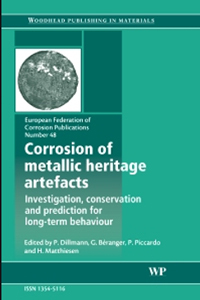
Corrosion Engineering, Science and Technology 2010
Corrosion of archaeological and heritage artefacts
Volume 45, Issue 5, 2010 pages 313-424.
Special edition of Corrosion Engineering, Science and Technology (CEST) which contains a range of articles by members of EFC Working Party 21. Assessment of treatment régimes, analysis of metals and investigation of corrosion mechanisms are amongst the topics covered. https://www.tandfonline.com/toc/ycst20/45/5
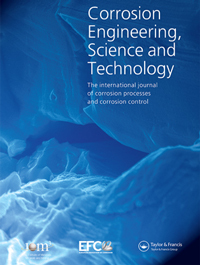
Previous activities
Collaborations with Working Parties in EFC
-
2023: Microbial corrosion and cultural heritage
- WP10 Microbial Corrosion
- Chairs Pierangela Cristiani, Régine Basseguy
- Chairs Pierangela Cristiani, Régine Basseguy
- WP10 Microbial Corrosion
-
2022: Atmospheric corrosion of cultural heritage
- WP25 Atmospheric Corrosion
- Chairs Tomas Prosek, Johan Tidblad
- Chairs Tomas Prosek, Johan Tidblad
- WP25 Atmospheric Corrosion
-
2020: Marine corrosion of cultural heritage
- WP9 Marine Corrosion
- Chair Philippe Refait
- Chair Philippe Refait
- WP9 Marine Corrosion
-
2017: Protection of cultural heritage
- WP14 Coatings
- Chair Wolfram Fürbeth
- WP1 Corrosion and Scale Inhibition
- Chair Günther Schmitt
- WP14 Coatings
